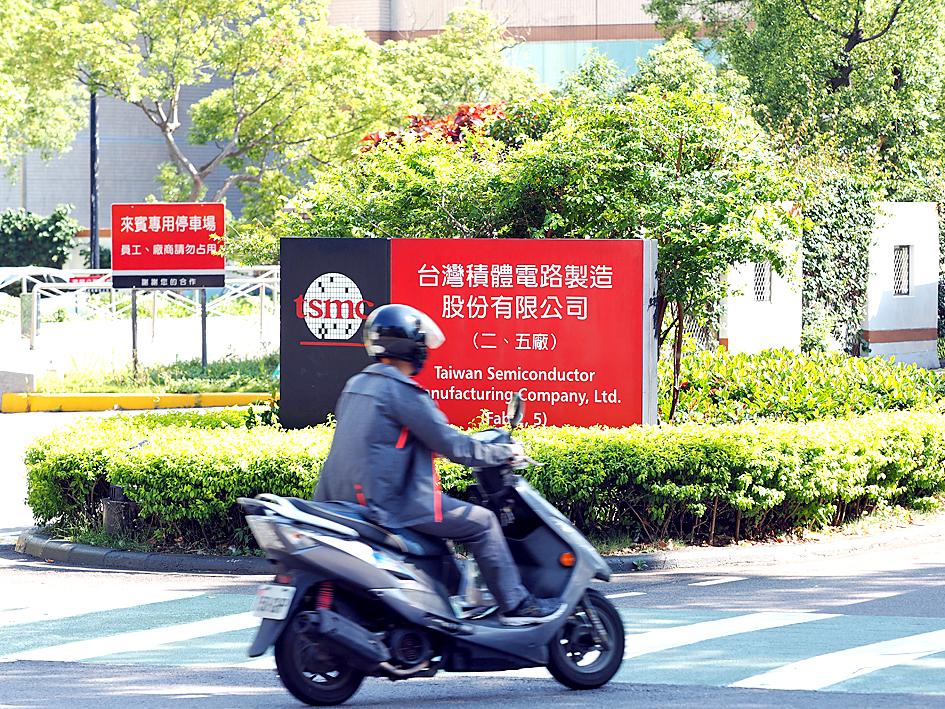Taiwan Semiconductor Manufacturing Co’s (TSMC, 台積電) plan to build an advanced wafer foundry in Arizona would not undercut its technological edge in Taiwan, economists said.
“When the planned Arizona plant using the 5 nanometer process starts production in 2024, TSMC will have advanced to the 2 nanometer process [in Taiwan],” Taiwan Institute of Economic Research (TIER, 台灣經濟研究院) research fellow Arisa Liu (劉佩真) said.
“Even if the US has the plant run by TSMC, Taiwan is expected to remain competitive as the Taiwanese semiconductor sector will own advanced technologies,” Liu said.

Photo: David Chang, EPA-EFE
On Friday, TSMC announced plans to invest US$12 billion to build the 5 nanometer fab, saying that construction is scheduled to start next year.
The 5 nanometer process is currently the world’s most advanced mass production process, but the company is developing a more sophisticated 3 nanometer process that could start mass production in 2022.
Liu said that TSMC’s 5 nanometer plant in Taiwan is expected to produce 80,000 wafers a month by the end of this year, four times the capacity of the planned US facility, and that is likely to grow next year.
At the same time, the investment in Arizona falls short of TSMC’s annual capital expenditure of between US$15 billion and US$16 billion, Liu added.
“So whether you look at [capital expenditure] or output,” TSMC and, by extension, Taiwan’s semiconductor industry, should maintain its lead, Liu said.
Stephen Su (蘇孟宗), head of the government-sponsored Industrial Technology Research Institute’s (工研院) Industrial Economics and Knowledge Center, said that TSMC chose Arizona as it is home to several semiconductor plants, including Intel Corp and NXP Semiconductors NV.
This would provide TSMC an existing supply chain to work with, Su said.
The state also has the advantages of dry weather and few natural disasters, such as earthquakes, Su said, adding that the higher labor costs in the US are not expected to be a problem because foundries are highly automated through cloud-based technologies.
Liu said that the proposed investment was likely a necessary move, because US-based businesses account for about 60 percent of its sales, and rising trade tensions between the US and China could force producers to move some production to the US.
Separately, Chinese state-backed funds pumped US$2.25 billion into a Semiconductor Manufacturing International Corp (SMIC, 中芯國際) wafer plant to support advanced chip manufacturing, as Washington tightens technology restrictions on China.
The SMIC plant’s registered capital jumped from US$3.5 billion to US$6.5 billion after the investment, the company said in an announcement on Friday.
The chipmaker’s stake in the Shanghai facility would fall from 50.1 percent to 38.5 percent, it said.
The plant has capacity to produce 6,000 14 nanometer wafers a month and plans to increase that to 35,000.
The investment came as Washington moved to prevent sales to Huawei Technologies Co (華為) from chipmakers using US technology.
The US Department of Commerce on Friday said it would require licenses before allowing US technology to be used by the Chinese company or its 114 subsidiaries, including its chip-design unit HiSilicon Technologies Co (海思半導體).
SMIC is planning a Shanghai share sale that could raise more than US$3 billion, based on its closing value of more than US$13 billion on Friday.
China is betting the local chipmaker could reduce the country’s reliance on US technology.

TEMPORARY TRUCE: China has made concessions to ease rare earth trade controls, among others, while Washington holds fire on a 100% tariff on all Chinese goods China is effectively suspending implementation of additional export controls on rare earth metals and terminating investigations targeting US companies in the semiconductor supply chain, the White House announced. The White House on Saturday issued a fact sheet outlining some details of the trade pact agreed to earlier in the week by US President Donald Trump and Chinese President Xi Jinping (習近平) that aimed to ease tensions between the world’s two largest economies. Under the deal, China is to issue general licenses valid for exports of rare earths, gallium, germanium, antimony and graphite “for the benefit of US end users and their suppliers

Dutch chipmaker Nexperia BV’s China unit yesterday said that it had established sufficient inventories of finished goods and works-in-progress, and that its supply chain remained secure and stable after its parent halted wafer supplies. The Dutch company suspended supplies of wafers to its Chinese assembly plant a week ago, calling it “a direct consequence of the local management’s recent failure to comply with the agreed contractual payment terms,” Reuters reported on Friday last week. Its China unit called Nexperia’s suspension “unilateral” and “extremely irresponsible,” adding that the Dutch parent’s claim about contractual payment was “misleading and highly deceptive,” according to a statement

The Chinese government has issued guidance requiring new data center projects that have received any state funds to only use domestically made artificial intelligence (AI) chips, two sources familiar with the matter told Reuters. In recent weeks, Chinese regulatory authorities have ordered such data centers that are less than 30 percent complete to remove all installed foreign chips, or cancel plans to purchase them, while projects in a more advanced stage would be decided on a case-by-case basis, the sources said. The move could represent one of China’s most aggressive steps yet to eliminate foreign technology from its critical infrastructure amid a

Nissan Motor Co has agreed to sell its global headquarters in Yokohama for ¥97 billion (US$630 million) to a group sponsored by Taiwanese autoparts maker Minth Group (敏實集團), as the struggling automaker seeks to shore up its financial position. The acquisition is led by a special purchase company managed by KJR Management Ltd, a Japanese real-estate unit of private equity giant KKR & Co, people familiar with the matter said. KJR said it would act as asset manager together with Mizuho Real Estate Management Co. Nissan is undergoing a broad cost-cutting campaign by eliminating jobs and shuttering plants as it grapples